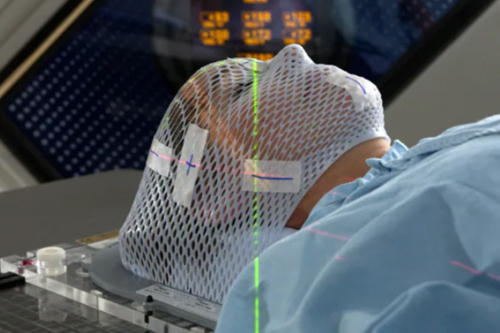
Stereotactic Surgery
Stereotactic surgery is a highly precise, minimally invasive technique used to diagnose and treat various neurological conditions. It utilizes three-dimensional imaging to guide instruments to specific targets in the brain or spine with minimal damage to surrounding tissues. This advanced surgical method has revolutionized neurosurgery, offering hope for patients with brain tumors, epilepsy, movement disorders, and more.
What is Stereotactic Surgery?
Stereotactic surgery (also known as stereotaxy) is a technique that allows surgeons to locate and operate on precise areas within the brain or spine using a coordinate-based system. It combines medical imaging (MRI, CT scans, or PET scans) with computer-assisted planning to guide instruments without large incisions.Unlike traditional brain surgery, which requires opening the skull, stereotactic surgery minimizes damage by using small holes or radiation-based approaches.
Key Features of Stereotactic Surgery:
- High precision: Uses 3D imaging for pinpoint accuracy.
- Minimally invasive: Reduces risks of bleeding and infection.
- Quick recovery: Shorter hospital stays and faster healing.
- Multiple applications: Used in tumor removal, biopsies, deep brain stimulation, and radiation therapy.
How Does Stereotactic Surgery Work?
Stereotactic surgery relies on a coordinate-based system, which consists of three main components:
1. Imaging Techniques
Before surgery, the patient undergoes imaging scans (MRI, CT, or PET). These scans help create a detailed 3D map of the brain or spine.
2. Stereotactic Frame or Frameless System
- Frame-based system: A metal frame is attached to the patient’s head, providing reference points for precise navigation.
- Frameless system: Uses optical or electromagnetic tracking for accuracy without a head frame.
3. Computer-Guided Targeting
Advanced software analyzes the imaging data, allowing the surgeon to determine the safest and most effective path for treatment.
4. Surgical Execution
- Insert fine needles or probes to perform biopsies.
- Implant electrodes for deep brain stimulation (DBS).
- Deliver radiation in precise doses (stereotactic radiosurgery).
Types of Stereotactic Surgery
Stereotactic surgery relies on a coordinate-based system, which consists of three main components:
1. Stereotactic Radiosurgery (SRS)
- Gamma Knife: Uses multiple beams of gamma radiation.
- CyberKnife: A robotic system delivering high-precision radiation.
- Linear Accelerator (LINAC)-based systems: Includes devices like Novalis and TrueBeam
2. Stereotactic Neurosurgery
- Stereotactic Biopsy: A small sample of brain tissue is removed for analysis.
- Deep Brain Stimulation (DBS): Electrodes are implanted in the brain to manage Parkinson’s disease and other movement disorders.
- Stereotactic Laser Ablation: Uses heat energy to destroy abnormal tissue.
- Stereotactic Endoscopy: A small camera is inserted for visualization and treatment.
Conditions Treated with Stereotactic Surgery
Stereotactic surgery relies on a coordinate-based system, which consists of three main components:
1.Brain Tumors
- Precise removal of tumors without damaging nearby structures.
- Used for gliomas, metastases, and pituitary adenomas.
2. Movement Disorders
- Parkinson’s disease: Deep Brain Stimulation (DBS) alleviates tremors and rigidity.
- Essential tremor: DBS or thalamotomy reduces severe hand tremors.
- Dystonia: Improves involuntary muscle contractions.
3. Epilepsy
- Identifies seizure-causing brain areas.
- Laser ablation or DBS can reduce seizure frequency.
4. Trigeminal Neuralgia
- Stereotactic radiosurgery provides long-term pain relief.
5. Stroke and Arteriovenous Malformations (AVMs)
- Radiosurgery effectively treats abnormal blood vessel formations.
6. Psychiatric Disorders
- OCD and severe depression may be treated with DBS.
Procedure Overview:
- Preoperative Planning
Detailed imaging (MRI, CT, or PET scans) is performed to map the target area. A stereotactic frame or a frameless navigation system is used to create a reference point for the surgeon to guide their tools. - Stereotactic Frame
In some procedures, a stereotactic frame is attached to a patient’s head. This frame serves as a reference system that helps the surgeon pinpoint the exact location of the lesion or target area in three dimensions. - Surgery
Small incisions are made, and specialized instruments (e.g., biopsy needles, electrodes, or lasers) are navigated to the precise location using the stereotactic coordinate system and real-time imaging. In radiosurgery, high doses of radiation are directed at the target without any incisions. - Postoperative Care
Recovery is usually faster than with traditional surgery, or the patients typically experience less pain and fewer complications. Depending on the procedure, they may go home the same day and a after the short hospital stay.
Advantages of Stereotactic Surgery:
- High Precision: Allows for highly accurate targeting of brain structures and minimizes damage to surrounding healthy tissues.
- Minimally Invasive: Procedures typically involve small incisions or none at all, reducing recovery time, pain, and risk of infection.
- Reduced Recovery Time: Patients generally experience faster recovery compared to traditional open surgery, often with shorter hospital stays.
- Versatility: Can be used for a wide range of conditions, from brain tumors and vascular malformations to epilepsy and movement disorders.
Benefits of Stereotactic Surgery
- High Accuracy: 3D mapping allows precise targeting, reducing collateral damage.
- Minimally Invasive: Reduces hospital stays, post-op pain, and risk of infections.
Effective for Inoperable Cases
Useful when traditional surgery is too risky. - Faster Recovery: Shortens rehabilitation time compared to open surgery.
- Reduces Complications: Lower risk of hemorrhage and infections.
Recovery and Post-Surgery Care
For Stereotactic Neurosurgery:
- Hospital stay: 1-2 days (outpatient for minor procedures).
- Resume light activities within a week.
- Follow-up MRI/CT scans ensure treatment success.
For Stereotactic Radiosurgery:
- Outpatient procedure, return home the same day.
- Fatigue and mild headaches may occur.
- Tumor effects may take weeks or months.Contact Us
Risks and Complications:
Although stereotactic surgery is generally safer than traditional surgery, it still carries some risks:
- Infection: Any invasive procedure carries a risk of infection, though it is minimized with smaller incisions.
- Bleeding: There is a risk of bleeding, especially in delicate brain structures.
- Damage to Nearby Structures: Despite the precision, there is a small risk of damage to nearby blood vessels, nerves, or brain tissue.
- Radiation Risks: In stereotactic radiosurgery, there is a potential risk of long-term effects from radiation exposure, although it is typically minimized with targeted delivery.Schedule your Consultation with Dr. Ritesh Nawkhare
